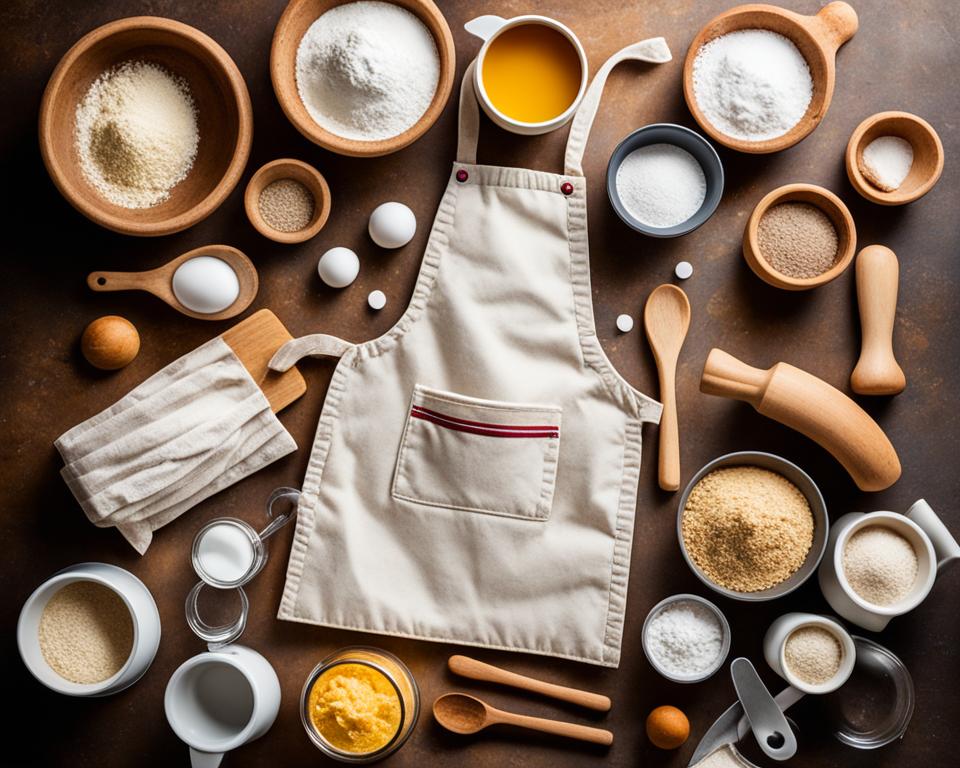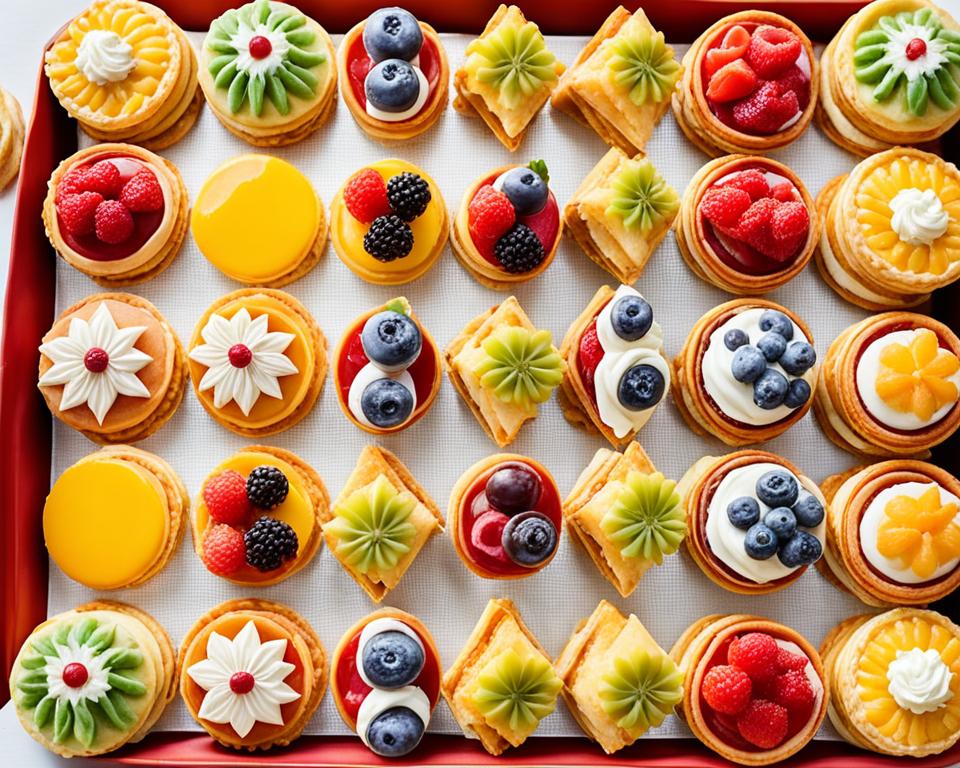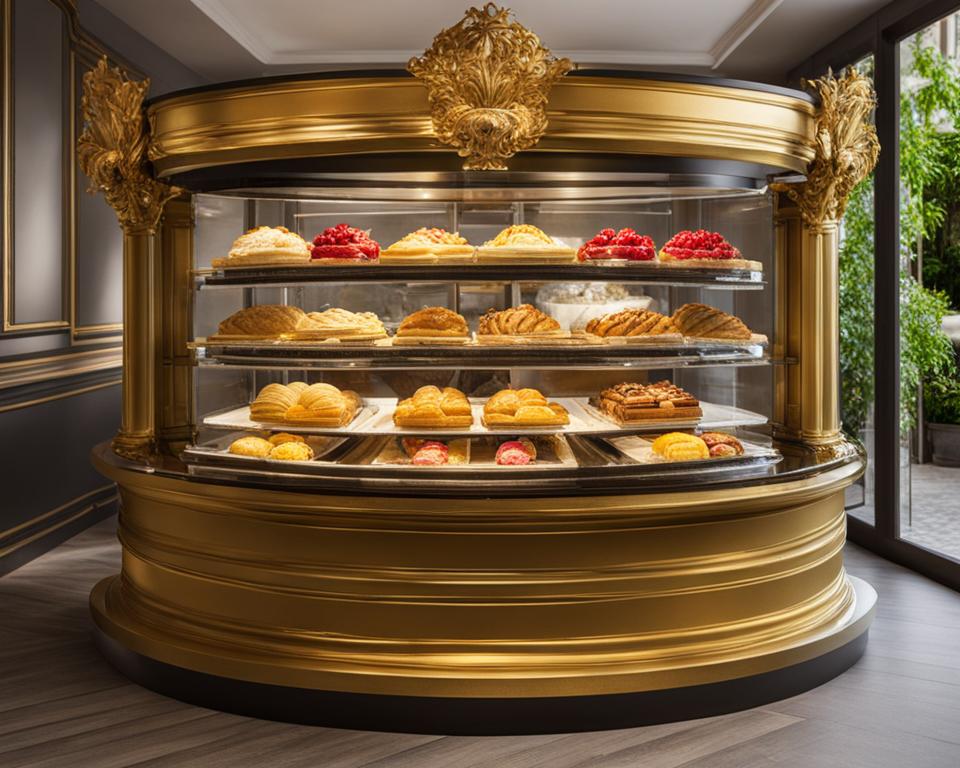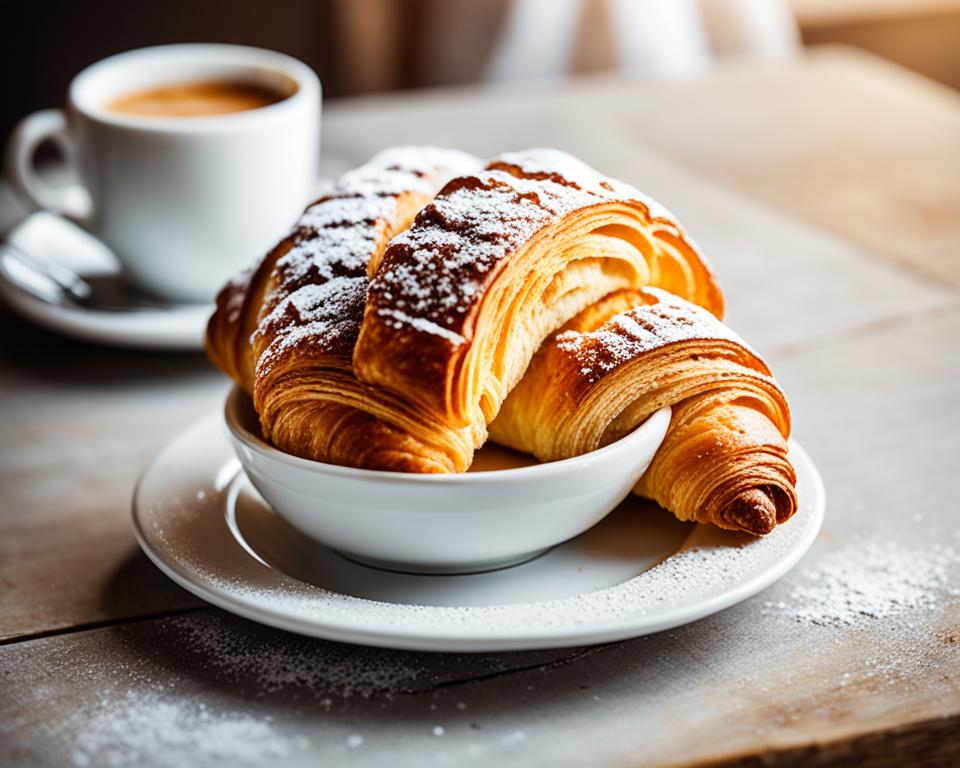Whether you can barely manage to make cake from a boxed mix or you tried your hand at croissants last weekend, we’re here to help you become a smarter, more confident baker. For the next 10 weeks, we’ll be sharing anytime-of-year baking recipes from lots of categories. We will provide essential baking rules, tips, techniques, and recipes of varying difficulty levels to help beginners elevate their home baking skills.
Baking can be a fun and rewarding hobby, but it can also be daunting for beginners. That’s why we’ve put together this comprehensive guide to give you all the essential baking wisdom you need to get started. Whether you’re looking for beginner baking tips, must-know baking techniques, or beginner-friendly baking advice, this guide has got you covered.
From mastering baking basics to understanding ingredients and following step-by-step instructions, we’ll walk you through each stage of the baking process. By the end of this guide, you’ll feel confident in your baking skills and ready to tackle a variety of recipes with ease.
Key Takeaways:
- Gain essential baking knowledge and techniques to elevate your home baking skills.
- Learn beginner-friendly tips and tricks to boost your confidence in the kitchen.
- Understand the importance of precise measurements and following recipes closely.
- Discover essential baking tools every beginner should have.
- Master the step-by-step baking process for consistent and successful results.
Level 1: Easy Recipes for Beginners
If you’re new to baking or have very little experience in the kitchen, level 1 recipes are the perfect starting point for you. These easy baking recipes are beginner-friendly and designed to build your confidence while giving you delicious results.
1. Chewy Chocolate Chip Cookie
Who doesn’t love a classic chocolate chip cookie? This easy chocolate chip cookie recipe will satisfy your sweet tooth and fill your home with the comforting aroma of freshly baked cookies. With simple ingredients and straightforward instructions, this recipe is a great introduction to baking.
2. Loaf Cake
A loaf cake is a versatile and simple baking recipe that’s a crowd-pleaser. Whether you prefer a traditional lemon loaf or a moist banana bread, this easy loaf cake recipe is perfect for enjoying with a cup of tea or coffee. It’s a great way to practice mixing and baking techniques while creating a delicious treat.
3. No-Knead Focaccia
If you’ve always wanted to try making bread but find the idea of kneading dough intimidating, this no-knead focaccia recipe is for you. With just a few ingredients and minimal effort, you can enjoy a homemade, crusty bread that’s perfect for dipping in olive oil or using as a sandwich base. It’s a great recipe for beginners to get a taste of the bread-making process without the hassle of kneading.
These level 1 recipes are the building blocks of your baking journey. As you conquer these easy recipes and gain confidence in the kitchen, you’ll be ready to move on to more challenging recipes and techniques.
Level 2: Intermediate Recipes for Advancing Skills
Level 2 recipes take beginners to the next stage of their baking journey. These recipes are designed to challenge and enhance the skills acquired in level 1. With step-by-step instructions, intermediate baking recipes provide an excellent opportunity to further develop your technique and expand your baking repertoire.
One of the distinguishing features of level 2 recipes is their emphasis on the use of senses. As an intermediate baker, you’ll rely not only on measurements and timers, but also on touch, smell, and sight to guide you through the baking process. This sensory experience deepens your connection with the ingredients and fosters a greater understanding of the science behind baking.
Some level 2 recipes are temperature-dependent, meaning that the result can vary based on the temperature at which the ingredients are handled or the oven temperature during baking. These recipes teach you the importance of precise temperature control and the impact it can have on the final outcome of your baked goods. By mastering temperature-dependent recipes, you’ll gain valuable insights into the subtleties of baking.
In addition, level 2 recipes may involve multiple components that need to be carefully prepared and assembled. This component-based approach allows you to explore the art of combining different elements to create harmonious and complex flavors and textures. From layering creams and fillings in a cake to assembling a multi-component dessert, these recipes will challenge your creativity and culinary skills.
Prepare to take your baking to the next level with a selection of intermediate recipes that will test your abilities and produce delicious results:
- A delicate strawberry shortcake with layers of moist sponge, fresh berries, and whipped cream.
- A rustic apple galette with a flaky and buttery crust, highlighting the flavors of sweet and tart apples.
- A classic baguette with a crispy exterior and soft, airy crumb, perfect for sandwiches or serving with butter and cheese.
By tackling level 2 recipes with diligence and enthusiasm, you’ll continue to advance your baking skills. The satisfaction of creating intricate and flavorful desserts will drive you to explore even more complex recipes and techniques in the future. Remember, great baking takes practice and patience, and every step forward brings you closer to baking mastery.
Level 3: Advanced Show-Stopping Recipes
Level 3 recipes are the epitome of finesse in baking, showcasing the mastery achieved by home bakers. These advanced baking recipes are designed to impress and leave a lasting impression. By this stage, beginners have honed their skills and are ready to tackle the more challenging aspects of baking.
One such advanced recipe involves rolling out perfectly buttery galette dough. Galettes are rustic, free-form tarts that can be filled with a variety of delicious ingredients. The galette dough requires meticulous attention to detail, as it must be rolled out thinly yet maintain its structure to hold the filling. The end result is a visually stunning and delectably flaky dessert that will leave your guests in awe.
Another advanced baking technique is working with enriched yeast dough. This dough is made with added butter, sugar, and eggs, resulting in a rich and tender texture. Mastering the art of shaping enriched yeast dough into a tight swirled log requires precision and patience. Once baked, the beautiful swirls add an elegant touch to any bread or pastry.
For visual reference, here is an example image of the galette dough:
| Ingredient | Measurement |
|---|---|
| All-Purpose Flour | 2 1/2 cups |
| Unsalted Butter | 1 cup (cold and cubed) |
| Salt | 1/2 teaspoon |
| Ice Water | 1/4 cup |
| Granulated Sugar | 2 tablespoons |
Here is a step-by-step guide to making the galette dough:
- In a food processor, combine the all-purpose flour, cubed unsalted butter, and salt. Pulse until the mixture resembles coarse crumbs.
- Add the ice water and pulse again until the dough starts to come together.
- Transfer the dough to a lightly floured surface and shape it into a disk.
- Wrap the dough in plastic wrap and refrigerate for at least 1 hour.
- Once chilled, roll out the dough into a circle, about 1/8 inch thick.
- Transfer the rolled-out dough to a baking sheet lined with parchment paper.
- Add your desired filling to the center of the dough, leaving a border around the edges.
- Gently fold the edges of the dough over the filling, creating pleats as you go.
- Bake in a preheated oven according to your recipe’s instructions.
- Allow the galette to cool slightly before serving. Enjoy!
Mastering these advanced baking recipes will elevate your skills to a whole new level. The show-stopping results will impress family and friends, and your finesse in baking will shine through every bite.
Understanding the Basics of Baking
Baking is a delightful combination of science and creativity. To achieve consistent and delectable results, it’s crucial to have a solid understanding of the basics. Let’s dive into the key elements that lay the foundation for successful baking.
The Importance of Precision
Precision is at the heart of baking. Unlike cooking, where you can often adjust seasonings as you go, baking requires exact measurements. Small deviations can significantly impact the final outcome of your baked goods. It’s essential to follow recipes closely and precisely measure each ingredient.
Proper equipment plays a crucial role in achieving precision. Here are some essential tools every baker should have:
| Measuring Tools | Mixing Tools |
|---|---|
|
|
Knowing Your Baking Ingredients
Each baking ingredient plays a unique role in the recipe, contributing to the texture, flavor, and structure of the final product. Here’s a quick overview of some common baking ingredients:
- Flour: Provides structure and stability to the baked goods. Different types of flour, such as all-purpose, bread flour, and cake flour, have varying protein contents, affecting the texture.
- Sugar: Adds sweetness and moistness to baked goods. It also aids in browning and caramelization.
- Fat: Enhances flavor, tenderness, and moisture. Butter, oil, and shortening are common fats used in baking.
- Eggs: Contribute to the structure, moisture, and richness of baked goods. They act as emulsifiers and provide leavening in some recipes.
- Leavening Agents: Such as baking powder and baking soda, create air bubbles and help dough and batter rise.
Precision, ingredients, and tools are the building blocks of successful baking.
Remember, precision in measuring ingredients and understanding their roles is paramount in achieving consistent and delicious results in baking.
Armed with these baking basics, you’re ready to embark on a journey of creating mouthwatering treats. Get ready to explore the wonderful world of baking and let your creativity shine!
Essential Baking Tools for Beginners
Starting with the right tools is crucial for beginners. Having the essential baking tools will not only make the baking process easier but also ensure more consistent and successful results. Here are some must-have baking tools for beginners:
- Mixing Bowls: A set of mixing bowls in different sizes is essential for combining ingredients and preparing various elements of a recipe.
- Measuring Cups and Spoons: Accurate measuring is key in baking, so having a set of measuring cups and spoons is essential for precise ingredient proportions.
- Spatulas: Spatulas are multipurpose tools that help you mix, scrape, and fold ingredients. Silicone spatulas are great for nonstick surfaces and are easy to clean.
- Whisks: Whisks are essential for whisking together ingredients, incorporating air into batters, and achieving smooth textures.
- Baking Pans: Invest in a few quality baking pans of different sizes and shapes for versatile baking options. Springform pans, cake pans, and muffin pans are some basic options to consider.
- Oven Thermometer: A reliable oven thermometer ensures accurate temperature control, allowing you to bake your creations at the right temperature for the best results.
Having these essential baking tools will set beginners up for success in their baking journey. With these tools at hand, they can confidently tackle any recipe and enjoy the process of creating delicious treats.
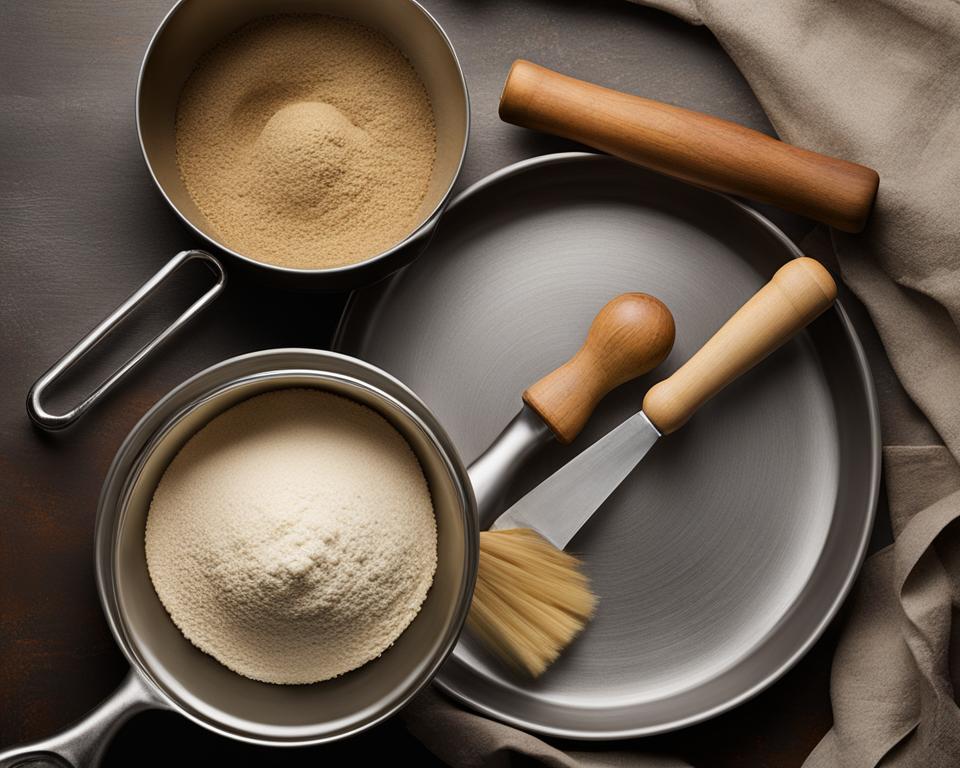
Step-by-Step Baking Process
Baking is all about precision and following a step-by-step approach. Whether you’re a beginner baker or looking to refine your skills, understanding the baking process is essential for success. In this section, we’ll explore the key steps involved in baking, from reading the recipe to preheating the oven and the final baking and cooling stages.
1. Reading the Recipe
Before you begin baking, take the time to thoroughly read the recipe. Pay close attention to the ingredients, measurements, and any special techniques or equipment required. Familiarize yourself with the steps involved to ensure a smooth baking experience.
2. Mixing Methods
Different recipes may call for different mixing methods, depending on the desired texture and structure of the baked goods. Common mixing methods include the creaming method for cakes and cookies, the folding method for delicate batters, and the rubbing-in method for pastry dough. Understanding the appropriate mixing technique for each recipe is key to achieving the desired results.
3. Oven Preheating
Preheating the oven is a crucial step in baking. It allows the oven to reach the desired temperature before you place your baked goods inside. Most recipes will specify the oven temperature and the preheating time required. Make sure to preheat the oven according to the recipe to ensure even baking and proper rising of your treats.
4. Baking and Cooling
Once your batter or dough is prepared, it’s time to transfer it to the oven and let the magic happen. Follow the recipe’s instructions for baking time and temperature. It’s important to resist the temptation to open the oven door during baking, as it can cause temperature fluctuations and affect the final outcome. After baking, allow your baked goods to cool completely before serving or decorating. This helps them set and develop their desired texture.
| Step | Description |
|---|---|
| 1 | Read the recipe thoroughly to understand the ingredients and steps involved. |
| 2 | Follow the appropriate mixing method for the recipe, such as creaming, folding, or rubbing-in. |
| 3 | Preheat the oven to the specified temperature to ensure even baking. |
| 4 | Place your batter or dough in the oven and bake according to the recipe’s instructions. |
| 5 | Allow your baked goods to cool completely before serving or decorating. |
Troubleshooting Common Baking Problems
Even experienced bakers encounter problems. Understanding and troubleshooting common baking issues can help beginners overcome obstacles and achieve successful results. Here are some common baking problems and tips on how to fix them:
Overmixing the Batter
Overmixing the batter can lead to dense and tough baked goods. It is important to mix just until the ingredients are combined to avoid overdeveloping the gluten. Overmixing can occur with a stand mixer, handheld mixer, or by hand. To prevent overmixing, use a lighter touch and stop mixing as soon as the ingredients are fully incorporated.
Tip: Incorporate dry ingredients into wet ingredients gradually, using a folding motion. This helps to minimize mixing time and avoid overmixing the batter.
Oven Temperature Issues
Oven temperature discrepancies can result in underbaked or overbaked goods. Inaccurate oven temperatures can be caused by a faulty oven thermostat or uneven heat distribution. To ensure proper baking, use an oven thermometer to monitor and adjust the temperature accordingly. If your oven tends to bake unevenly, consider rotating the baking pan halfway through the baking process.
Tip: Preheat your oven for at least 10-15 minutes before placing your baked goods inside. This allows for consistent heat distribution and more accurate baking results.
Uneven Rising
Uneven rising can lead to lopsided or sunken baked goods. This problem can be caused by several factors, including improper yeast activation, inaccurate measurements, and improper shaping or handling of dough. To promote even rising, make sure your yeast is fresh and activated properly. Measure ingredients accurately, following the recipe closely. Additionally, take care to shape and handle dough gently to avoid deflating it.
Tip: When working with yeast-based dough, proof the yeast in warm water (around 110°F) with a touch of sugar before incorporating it into the dough. This ensures that the yeast is active and helps in achieving a good rise.
If you encounter any of these baking problems, don’t be discouraged. With practice and attention to detail, you can overcome these issues and continue to improve your baking skills. Remember to follow recipes closely, use the right techniques, and learn from your baking experiences. Troubleshooting common baking problems will help you become a more confident and successful baker!
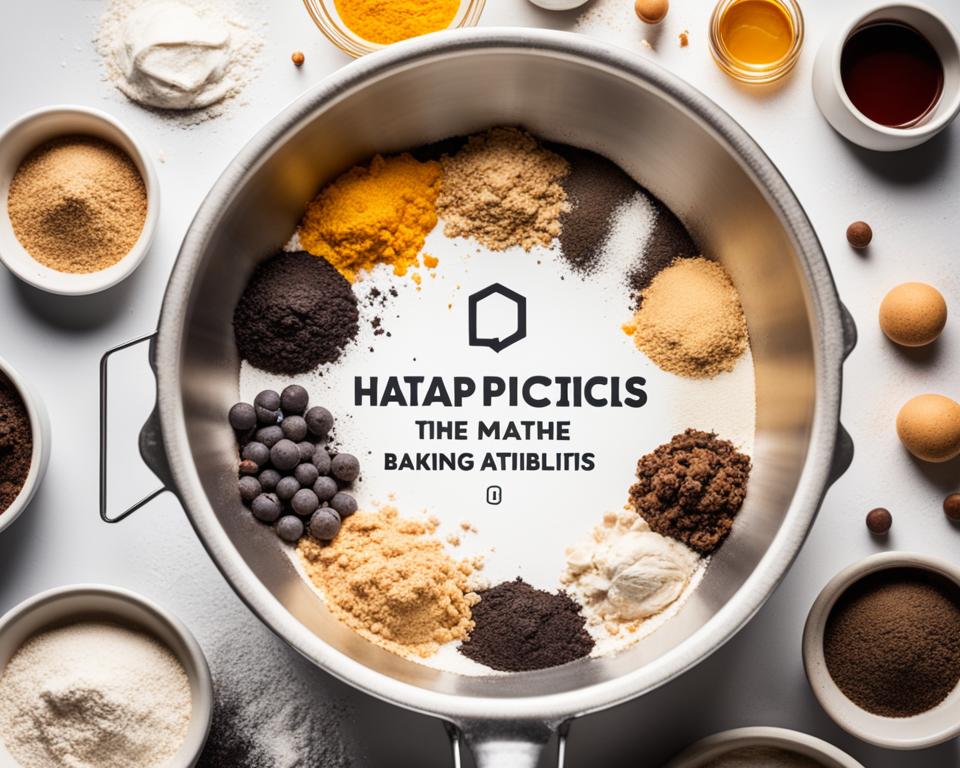
Experimenting and Learning in Baking
Once beginners are comfortable with the basics of baking, they can embark on an exciting journey of experimentation and learning. Trying new baking techniques, flavor variations, and ingredient substitutions not only adds creativity to your baking but also helps expand your skills and knowledge in the kitchen. Each experiment and mistake is an opportunity for growth and discovery, paving the way for becoming a more confident and versatile baker.
Flavor Variations
One way to experiment in baking is by exploring different flavor profiles. Take a basic recipe, such as a classic vanilla cake, and infuse it with unique flavors like citrus zest, spices, or extracts. By playing with flavors, you can create delightful and unexpected combinations that cater to your personal taste preferences. Don’t be afraid to think outside the box and get creative with your flavor choices.
Trying New Baking Techniques
Expanding your baking repertoire involves trying new techniques. Explore different methods of mixing, such as the creaming method, the folding method, or the rubbing-in method. Each technique imparts a distinct texture and structure to your baked goods. By stepping out of your comfort zone and learning new techniques, you can develop a wider range of skills and produce more diverse and impressive creations.
Ingredient Substitutions
Another way to experiment in baking is by substituting ingredients. Whether it’s using alternative flours, replacing dairy with non-dairy options, or swapping out sugars with natural sweeteners, ingredient substitutions allow you to customize recipes based on dietary preferences or availability. However, it’s important to understand the functionality of each ingredient and how substitutions may affect the final outcome. It’s a trial-and-error process that encourages you to become more resourceful and adaptable in the kitchen.
“Experimentation is the key to discovering new flavors, techniques, and possibilities in baking. Embrace the freedom to play, learn, and grow through hands-on experience.”
Learning from your mistakes is an integral part of the baking journey. Don’t be discouraged by failures but rather view them as valuable lessons. Analyze what went wrong, adjust your approach, and try again. With each attempt, you’ll gain a deeper understanding of the science behind baking and develop the intuition to make informed decisions when experimenting with new ideas.
| Experimenting in Baking Tips | Learning from Mistakes |
|---|---|
| 1. Start with small modifications and gradually increase complexity | 1. Analyze what went wrong and why |
| 2. Keep a baking journal to track your experiments | 2. Make note of adjustments for next time |
| 3. Seek inspiration from cookbooks, online resources, and other bakers | 3. Embrace failure as an opportunity for growth |
| 4. Taste and evaluate your creations objectively | 4. Enjoy the process of continuous learning and improvement |
Experimenting and learning in baking is a rewarding and ongoing process. As you gain more confidence and knowledge, don’t be afraid to push the boundaries of traditional recipes and techniques. Embrace the joy of discovery, and let your creativity shine through your delectable creations.
The Delicious Recipes in Anna Olson’s Baking Wisdom
Anna Olson’s Baking Wisdom is a treasure trove of delectable recipes that will delight any baking enthusiast. Organized into different chapters, this book offers a wide range of delicious treats for every occasion.
Recipe Chapters
Anna Olson’s Baking Wisdom is divided into the following recipe chapters:
- Essentials
- Pies & Tarts
- Pastries
- Cakes
- Custards & Creams
- Confections
- Cookies & Bars
- Breads
Each chapter explores a specific category of baked goods, ensuring there’s something for everyone to enjoy.
Sample Recipes
Within the pages of Anna Olson’s Baking Wisdom, you’ll find an array of mouthwatering recipes. Here are just a few examples:
- Peanut Butter Banana Cookies
- Classic Cheese Soufflé
- Creamy Chocolate Pudding
These recipes showcase Anna Olson’s expertise in creating irresistible treats that will satisfy even the most discerning sweet tooth.
Experience the joy of baking with Anna Olson’s Baking Wisdom and indulge in the delightful flavors and textures of her incredible recipes.
Conclusion
In conclusion, baking is a fulfilling and enjoyable activity that can be mastered by beginners with the right approach. Through practice, patience, and precision, aspiring bakers can develop their skills and gain confidence in the kitchen. By following essential baking rules, understanding the role of ingredients, utilizing the appropriate tools, and diligently following step-by-step instructions, beginners can improve their techniques and create delicious baked goods.
Remember, practice makes perfect. Each baking session offers an opportunity to learn and grow. Embrace the process of experimenting with different flavors, trying new techniques, and learning from any mistakes along the way. With time and dedication, anyone can become a proficient baker and master the art of creating delectable treats.
So, whether you’re just starting or have dabbled in baking before, don’t be discouraged. Keep honing your skills, exploring different recipes, and expanding your baking repertoire. With the essential baking wisdom shared in this guide, you’re equipped to embark on a delicious baking journey. Happy baking!
FAQ
What is the essential baking wisdom for starters guide?
The essential baking wisdom for starters guide is a comprehensive resource that provides beginner baking tips, techniques, and must-know baking tips to help novice bakers become smarter and more confident in the kitchen.
What are level 1 recipes?
Level 1 recipes are designed for beginners with very little skill. These easy recipes include a chewy chocolate chip cookie, a loaf cake perfect with a cup of tea, and an easy no-knead focaccia. They provide a great starting point for novice bakers to gain confidence and experience.
What are level 2 recipes?
Level 2 recipes build upon the skills acquired in level 1. These slightly more advanced recipes may be temperature dependent or component-based. With diligence, beginners will be rewarded for their efforts and continue to develop their baking skills.
What are level 3 recipes?
Level 3 recipes are the pinnacle of baking expertise. These show-stopping recipes require finesse and showcase the baking mastery achieved by beginners. Recipes include rolling out buttery galette dough and shaping enriched yeast dough into a tight swirled log.
Why is precision important in baking?
Baking requires precision, with measurements needing to be exact and ingredients at the right temperature. Proper measuring tools and following recipes closely are essential for consistent results.
What are the essential baking tools for beginners?
Essential baking tools for beginners include mixing bowls, measuring cups and spoons, whisks and spatulas for mixing, baking pans of various sizes, and an oven thermometer for accurate temperature control.
What is the step-by-step baking process?
The step-by-step baking process involves thoroughly reading the recipe, understanding each step, and preparing all ingredients and tools in advance. Different baked goods may require different mixing methods, and preheating the oven ensures even baking. Following baking and cooling instructions is essential to complete the cooking process.
How can I troubleshoot common baking problems?
Troubleshooting common baking issues involves tips such as mixing just until ingredients are combined, using an oven thermometer for temperature accuracy, and ensuring even oven temperature and proper mixing techniques.
How can I experiment and learn in baking?
Once beginners are comfortable with the basics, they can start experimenting and trying new techniques in baking. This includes adding different flavors, substituting ingredients for different textures, and learning from mistakes to grow and master the art of baking.
What recipes are found in Anna Olson’s Baking Wisdom?
Anna Olson’s Baking Wisdom offers a wide range of delicious recipes organized into different chapters, including essentials, pies & tarts, pastries, cakes, custards & creams, confections, cookies & bars, and breads. Recipes such as peanut butter banana cookies, classic cheese soufflé, and creamy chocolate pudding are just a taste of the delectable treats found in this book.
What is the key to successful baking for beginners?
The key to successful baking for beginners is practice, patience, and precision. By following essential baking rules, understanding ingredients, using the right tools, and following step-by-step instructions, beginners can improve their skills and confidence in the kitchen. With time and practice, anyone can become a proficient baker and create delicious baked masterpieces.

